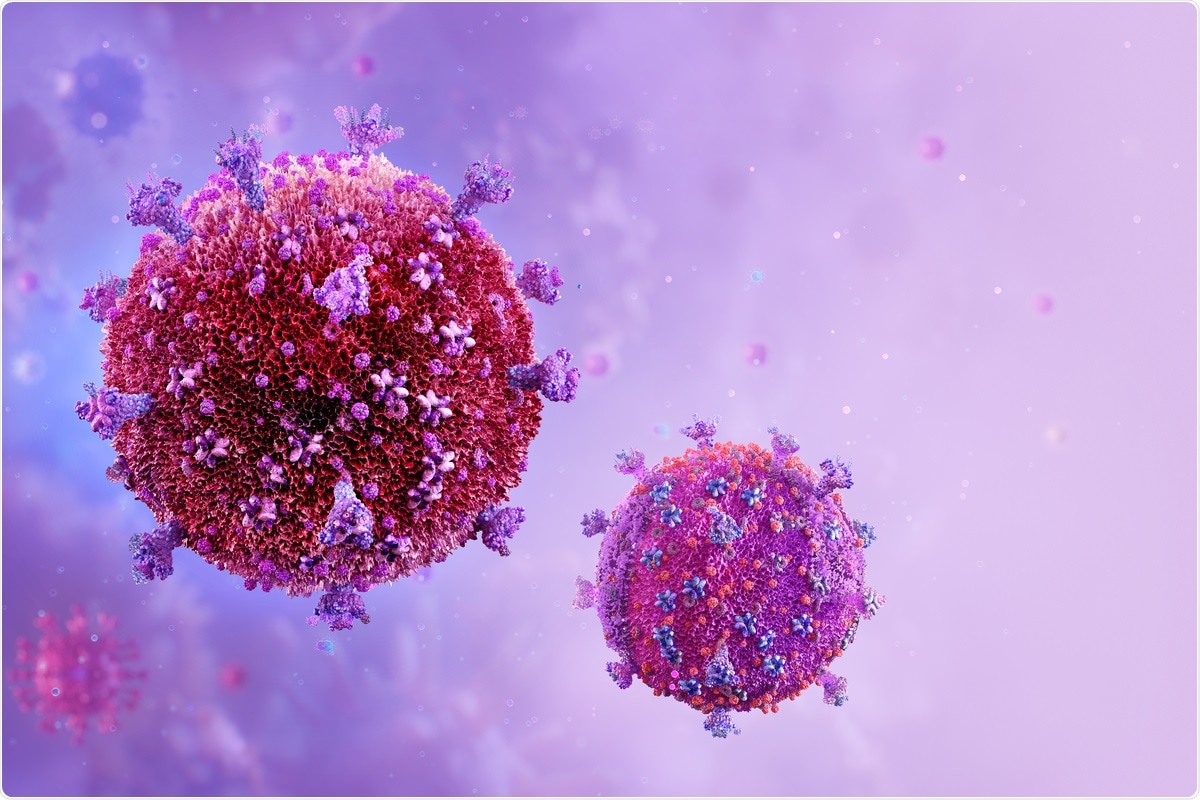The concentration of the proteins S100A8 and S100A9 in serum increases during an inflammatory response. Patients infected with severe acute respiratory syndrome coronavirus 2 (SARS-CoV-2) show elevated serum levels of S100A8 and S100A9. Additionally, the S100A8/A9 complex is considered a biomarker of SARS-CoV-2 infection and is involved in inducing cytokine storms.
 Study: S100A8 and S100A9, biomarkers of SARS-Cov2-infected patients, suppress HIV replication in primary macrophages. Image Credit: Corona Borealis Studio/ Shutterstock
Study: S100A8 and S100A9, biomarkers of SARS-Cov2-infected patients, suppress HIV replication in primary macrophages. Image Credit: Corona Borealis Studio/ Shutterstock
A new study investigates the role of the S100A8/A9 complex in the replication of the human immunodeficiency virus (HIV). The findings of this study provide insights into the regulation of HIV viral loads in SARS-CoV2 co-infection. A preprint version of the study, which is yet to undergo peer review, is available on the bioRxiv* server.
S100A8 and S100A9
S100A8 and S100A9 are low molecular weight acidic proteins, also known as myeloid-related protein (MRP) 8 and MRP14. They regulate calcium buffering, cell differentiation, cell proliferation, cytoskeletal–membrane interactions, embryogenesis, cell migration, and inflammation. S100A8 and S100A9 are expressed during acute and chronic inflammatory diseases. They are constitutively expressed in neutrophils and monocytes as homodimers or heterodimer complexes (S100A8/A9). They are induced in macrophages upon stimulation. S100A8, S100A9 and S100A8/A9 act as chemoattractants for neutrophils. S100A9 and S100A8/A9 enhance monocyte transmigration across endothelial cells.
S100A8/A9 and SARS-CoV-2 infection
During inflammation, the concentration of S100A8 and S100A9 in serum may rise at local sites of inflammation. The S100A8/A9 complex released from neutrophils has been identified as a novel biomarker of SARS-CoV-2 infection.
Mechanistically, the S100A8/A9 complex is an endogenous ligand of Toll-like receptor 4 (TLR4) on dendritic cells (DC), and cytosolic S100A9 suppresses HIV replication by inhibiting reverse transcription. Conversely, some studies show that S100A8 or S100A9 act as HIV inducers/activators. However, the role of each S100A protein on HIV replication in primary cells is still unknown.
In people living with HIV (PLWH) with poorly controlled viral load, co-infection with SARS-CoV2 may result in an immunocompromised status.
This study assesses the functions of S100A8 and S100A9 in HIV replication in primary macrophages and T cells.
S100A8 and S100A9 exhibit anti-HIV effects
To assess the role of S100A8 and S100A9 in HIV replication in primary cells, the scientists infected primary cell lines, activated CD4+-T cells, and CD14+ monocytes differentiated into macrophages (MDMs) with the virus, and cultured the cells with physiological concentrations S100A8/A9 in the medium.
The S100A8/A9 complex had no impact on HIV replication in the primary cell lines tested.
The scientists then cultured the HIV-infected cells in the presence of different concentrations of S100A8 or S100A9. Both proteins did not affect HIV replication in primary T cells. However, they inhibited HIV replication in MDMs in a dose-dependent manner.
To further characterize the anti-HIV effect, the scientists pre-treated MDMs with each protein and then infected the pre-treated cells with HIV. Infected cells were cultured in the absence of S100 proteins. Monitoring of viral replication revealed that the S100A8 and S100A9 pre-treatment was sufficient to suppress HIV replication.
S100A8 and S100A9 suppress HIV replication during reverse transcription
S100A8 and S100A9 may inhibit HIV by suppressing virus binding to receptors or suppressing HIV replication during reverse transcription after infection.
To elucidate this, the scientists performed HIV binding assays using qRT-PCR. Pre-treated cells were incubated with HIV, total RNA was extracted, and qRT- PCR was conducted. Pre-treatment did not affect HIV binding.
The scientists then evaluated the inhibitory effects on reverse transcription by measuring the copy numbers of proviral DNA using qPCR.
HIV-infected cells were cultured and genomic DNA was extracted, and qPCR was conducted. S100A8 and S100A9 pre-treatment decreased proviral DNA copy numbers.
It is known that Spectrin Non- Erythrocytic 1 (SPTBN1) plays a key role in HIV replication, and downregulation of the expression of SPTBN1 suppresses HIV reverse transcription. The scientists performed Western blotting using cell lysates from the pre-treated cells to analyze SPTBN1 expression. S100A8- and S100A9 pre-treatment demonstrated a partial downregulation of SPTBN1 expression.
In conclusion, S100A8 and S100A9 do not affect HIV binding but inhibit HIV replication, possibly via SPTBN1, which may be involved in HIV inhibition in the pre-treated cells.
Implications of the study
- The concentrations of S100A8/A9 proteins increase in patients with SARS-CoV2 infection. However, this study indicates that the S100A8/A9 complex does not alter HIV replication in primary cells.
- Also, one previous study has indicated that HIV replication is enhanced by S100A8 and S100A9. This means that even though the protein concentration is elevated in PLWH co-infected with SARS-CoV2, these proteins may not directly enhance HIV replication but may inhibit HIV replication.
- Since S100A8 and S100A9 are extracellular inhibitors, they may be considered for therapeutic applications.
*Important notice
bioRxiv publishes preliminary scientific reports that are not peer-reviewed and, therefore, should not be regarded as conclusive, guide clinical practice/health-related behavior, or treated as established information.
- Oguariri, R. et al. (2021) "S100A8 and S100A9, biomarkers of SARS-Cov2-infected patients, suppress HIV replication in primary macrophages". bioRxiv. doi: 10.1101/2021.10.20.464686.
Posted in: Medical Science News | Medical Research News | Disease/Infection News
Tags: Biomarker, Calcium, CD4, Cell, Cell Migration, Cell Proliferation, Chronic, Coronavirus, Coronavirus Disease COVID-19, Cytokine, DNA, Embryogenesis, Genomic, HIV, Immunodeficiency, Inflammation, Ligand, Membrane, Monocyte, Neutrophils, Proliferation, Protein, Receptor, Respiratory, RNA, SARS, SARS-CoV-2, Severe Acute Respiratory, Severe Acute Respiratory Syndrome, Syndrome, Transcription, Virus

Written by
Dr. Shital Sarah Ahaley
Dr. Shital Sarah Ahaley is a medical writer. She completed her Bachelor's and Master's degree in Microbiology at the University of Pune. She then completed her Ph.D. at the Indian Institute of Science, Bengaluru where she studied muscle development and muscle diseases. After her Ph.D., she worked at the Indian Institute of Science, Education, and Research, Pune as a post-doctoral fellow. She then acquired and executed an independent grant from the DBT-Wellcome Trust India Alliance as an Early Career Fellow. Her work focused on RNA binding proteins and Hedgehog signaling.
Source: Read Full Article
